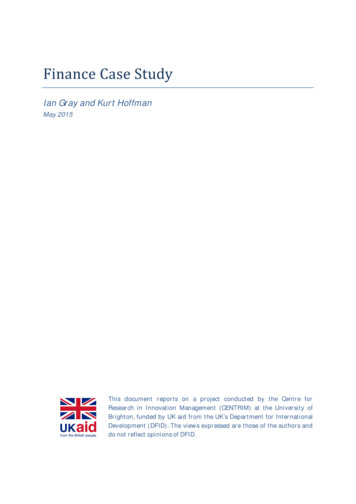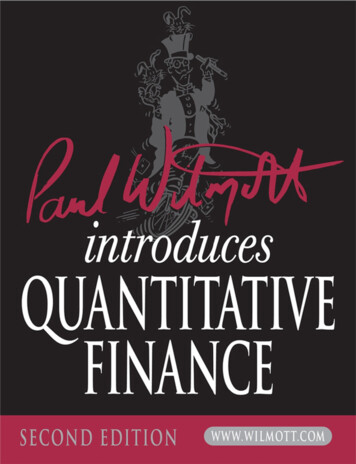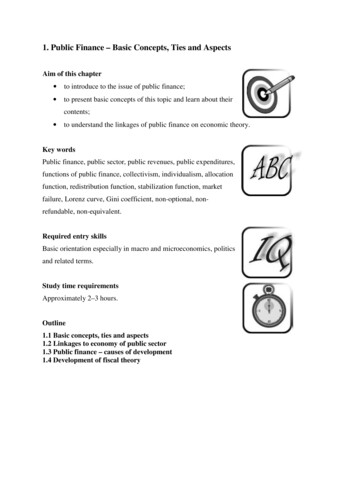
Transcription
Finance Case StudyIan Gray and Kurt HoffmanMay 2015This document reports on a project conducted by the Centre forResearch in Innovation Management (CENTRIM) at the University ofBrighton, funded by UK aid from the UK’s Department for InternationalDevelopment (DFID). The views expressed are those of the authors anddo not reflect opinions of DFID.
Executive SummaryHumanitarian needs have increased over the past few decades and are projected to increasedramatically in the coming years. The world that is emerging is urban, increasingly buffeted bythe effects of climate change. The old paradigm of state vs. state conflict no longer covers therise in non-state actors bringing instability and conflict to every continent. Generations aregrowing up and having their own children in the same refugee and IDP (Internally DisplacedPeople) camps they were born in.Funding for humanitarian response is lagging behind the rising needs. The current ways ofworking are becoming outmoded in many ways, adding further strain to the system. This reportseeks to understand how products, processes, services and organisations that are seeking tomake positive changes are being funded and supported.There have been innovations that have emerged in the past decades which start to meet thesenew challenges. The rise of cash transfers, the use of social media and the change in thetreatment of acute malnutrition to name just a few. These three innovations alone have savedthe lives and livelihoods of hundreds of thousands, if not millions of people. In order to be fit forpurpose, the humanitarian challenges of today and the future require the humanitarian systemto increase the number and impact of such innovations.In the past five years there has been a growing movement of support for innovation within thesector. In a few donors and a number of implementing agencies and private sectororganisations humanitarian innovation funds have been developed, jobs, teams and labscreated, and innovations piloted. These steps have been small, when set against the size of thesystem, but they have been significant. These initial steps need to be followed with a secondwave of financial and non-financial support if the current humanitarian system is to be able torespond to the increasing number of lives and livelihoods that will be impacted by disasters inthe coming years and decades.This Finance for Humanitarian Innovation report is one of five topic-specific studies conductedas part of the Humanitarian Innovation Ecosystem Mapping Project being carried out byCENTRIM of the University of Brighton on behalf of DFID. The overarching goal of the project isto map and assess the drivers, elements and process of innovation within the humanitariansector, using an ecosystem framework and analytical approach derived from the field ofinnovation management.The other case studies focus on the shelter; cash based programming, WASH and health sectors.The aim of these studies was to provide an, in-depth and comparative look at the nature andcharacter of innovation within each sector and to situate these against our evolvinginterpretation of the Humanitarian Innovation Ecosystem. This innovation finance study seeksto understand the level of financing and support for innovation across the humanitariansystem.Through nearly 40 interviews, reviews of data from the other studies and secondary data1
analysis, we have been able to piece together a sense of what is happening regarding financingof humanitarian innovation. The key finding is that the humanitarian system has made a start infunding innovation, but that it is still a long way from where it needs to be. Our research leadsus to estimate that, although growing, funding for humanitarian innovation is low. We estimatethat innovation funding by OECD DAC members is around US 37.5 million per year, theequivalent of 0.27% of their humanitarian response funding in 2013. This percentage would beexceptionally low in an industry that had little material consequence, such as paper milling. Inan industry seeking to save and support millions of lives and livelihoods in the face of disaster, itis not exceptionally low; it is breathtakingly low.The structure of the report looks at the methodology, concepts and frameworks, before movingon to an overview of the sector. In the overview section, there is an outline of the financing byactor group, followed by comparisons with the private sector and social innovation sector. Inthe next section we provide an analysis of different actors in order to give a flavour of what ishappening in the sector. We then identify 14 challenges that are impeding greater investmentand support for innovation. These include:The Principal-Agent FeedbackLoop Challenge: Dealing withdeficiencies of the supply led,intermediated humanitariansystemThe Funding Challenge:Current funding levels forinnovation are too low, byany industry standard.The Financial PhasesChallenge: Funding phasesneed to be expanded in orderto enable better riskmanagement.The Monitoring and EvaluationChallenge: The lack of evidence,and the need for consistentapproaches and frameworks arestifling investment.The Support Challenge:Finances are not enough. Adeeper support ecosystem forinnovations needs to beinvested in.The Business ModelChallenge: Many innovationslack sustainable businessmodels that are economicallyviable.The Dominant Design Challenge:There is an inhibition in investingin scaling innovations due to fearsof backing a ‘loser’.The Compounded RiskChallenge: The system hasmultiple levels of riskaversion that arecompounding each other.The Rules Challenge: Thereare a number of rules andpolicies that stifle innovation,such as anti-collaborativeprocurement rules.The Forward CommitmentChallenge: Agreed projections ofrising humanitarian need are notbeing translated intocommensurate forward planningand purchasing.The Barriers to EntryChallenge: The sector isdominated by incumbents.New entrants find it difficultto break in.The Adoption Challenge:Implementing agencies arepoor at adopting innovationsfrom each other, creatingduplication and stiflingscaling.The Competency Challenge: Thefield of humanitarian innovation isnew. There is a need to buildsystem wide competencies.The TransparencyChallenge: Visibility into thespending on innovationacross the system is opaque,impacting decision makingand coherence.2
The report follows these challenges with recommendations targeted at the actor groups;donors, private sector and the UN, INGOs and Red Cross Movement.3
Table of ContentsExecutive Summary. 1Acronyms . 5Introduction . 7Concepts and Frameworks . 7Overview of the Sector . 8Comparison of the Private Sector and Humanitarian Sector Innovation Ecosystems.8Innovation in the Private Sector . 9Innovation in the Humanitarian Sector . 10Financing by Actor Group.10Traditional Donors . 11Private Sector and Foundations . 13NGOs & Red Cross Movement . 15UN Agencies . 15Innovation Donors: Investors or Customers? . 16Timing and Planning for Innovation.17Financing Structure .17Social Impact Investing.20Support types. 21Mini Case Studies . 22The Partnership Model - IKEA Foundation .22The Pooled Funding Model - Humanitarian Innovation Fund (HIF).23The Services-in-Kind Model - Deloitte .23The Venturing Model - Qatar Computer Research Institute. 24The Issue Focused Model – Luxembourg Development Cooperation and HumanitarianDepartment .24Innovations Strategy and Portfolio Management Model – DFID. 25Conclusions. 25The Principal-Agent Feedback Loop challenge . 25The Funding Challenge .26The Financial Phases challenge . 26The Maturity Challenge .26The Monitoring and Evaluation Challenge .27The Support Challenge .27The Business Model Challenge. 27The Dominant Design Challenge . 27The Compound Risk Challenge . 28The Rules Challenge .28The Forward Commitments and Procurement Challenge.28The Barriers to Entry Challenge. 29The Adoption Challenge .29The Competency Challenge .29The Transparency Challenge . 304
Recommendations . 30Institutional Donors .30Private Sector and Foundations . 31The Three Pillars: UN, NGOs and Red Cross Movement .32Annex 1: Social Impact Innovation and Investing References . 33Annex 2: Findings related to the Humanitarian Innovation Ecosystem Models . 34Bibliography.
Finance Case Study Ian Gray and Kurt Hoffman May 2015 This document reports on a project conducted by the Centre for Research in Innovation Management (CENTRIM) at the University of Brighton, funded by UK aid from the UK’s Department for International Development (DFID). The views expressed are those of the authors and do not reflect opinions of DFID. 1 Executive Summary










